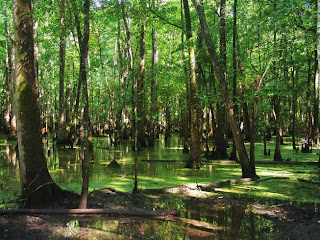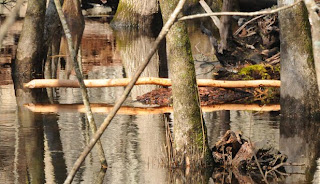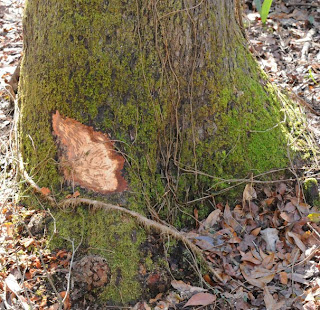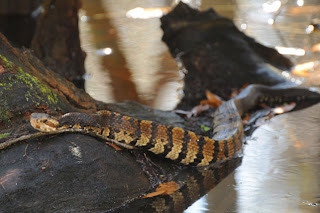As noted previously in this blog, beavers (Castor canadensis) have constructed a dam in the swamp. Unfortunately, the dam cannot be seen from the boardwalk and it is not feasible to take 70 students off the boardwalk along the rain-soaked swamp edge to see it. However, the recent rains have created drainage channels along the low, educational boardwalk next to the nature center. Using the natural terrain and drainage pattern along the low boardwalk, students were given the opportunity to direct their guide in constructing dams of sticks and leaves. Two sites, one with a single channel and one with a broad flood plain, were used to demonstrate how a beaver dam can change the habitat.
The South Carolina science standard addressed was:
4-2.6 Explain how organisms cause changes in their environment.
Once at the first site, students were asked to discuss the following within their small groups:
- What do beavers eat? (plant material, especially cambium)
- What do beavers build? (dams, lodges)
- How do beavers build their structures? (using logs, branches, mud, leaves)
- Where do beavers build their structures? (dams in channels of flowing water, lodges in pooled water)
Once students shared their answers, each group had the opportunity to suggest where a beaver might construct a dam at the site. Though most would have preferred to jump off the boardwalk and into the water and mud, we were certain that those responsible for the laundry would want to have a word or two with us. Therefore, we opted for the next best thing. With great excitement, students/beaver engineers directed their guide on how and where to construct the dams using nearby sticks and leaves. Who knew there were so many expert dam makers in our community?
After observing the results, the group moved to the second site and repeat dam construction procedures. The second site was a better representation of what the beavers have accomplished in the swamp. There was not one obvious channel to block and natural features (trees, logs, and high ground) were incorporated into the dam's construction. After observing the results of the second dam, students discussed the following questions within their small groups:
After observing the results, the group moved to the second site and repeat dam construction procedures. The second site was a better representation of what the beavers have accomplished in the swamp. There was not one obvious channel to block and natural features (trees, logs, and high ground) were incorporated into the dam's construction. After observing the results of the second dam, students discussed the following questions within their small groups:
- How did the dams immediately affect the habitat upstream from the dam? (water pooled; deeper, more-consistent levels of water behind the dam; some plants may be in the water more often than before)
- What species might benefit from the change in habitat? (trees or aquatic plants that need or can tolerate constant flooding; fish; frogs; water snakes; wading birds that eat those species; dabbling ducks and geese; bitterns that like thicker, marsh-like habitat)
- How do dams immediately affect the habitat downstream from the dam? (less water, other plant species may be able to grow in the drier conditions)
- Over time, how will the habitat behind the dam change? (sedimentation will fill the pool and create higher ground and meadow-like conditions and eventually habitat as seen along the swamp’s edge; or the habitat may attract the attention of an alligator, which may eat the beavers allowing the dams to fall into disrepair and the swamp to reclaim the area)
Since the actual beaver dam would remain out-of-sight, students used the iPod Touches to view the beaver dam video and peruse the beaver-related images. Students could also look in the other image folders for species that they previously identified as having benefited from the beavers’ damming activity.
By the end of the activity and boardwalk tour, the students were expert dam engineers and had no problems writing a letter to the editor for or against the presence of beavers and their construction work in the swamp.

















































